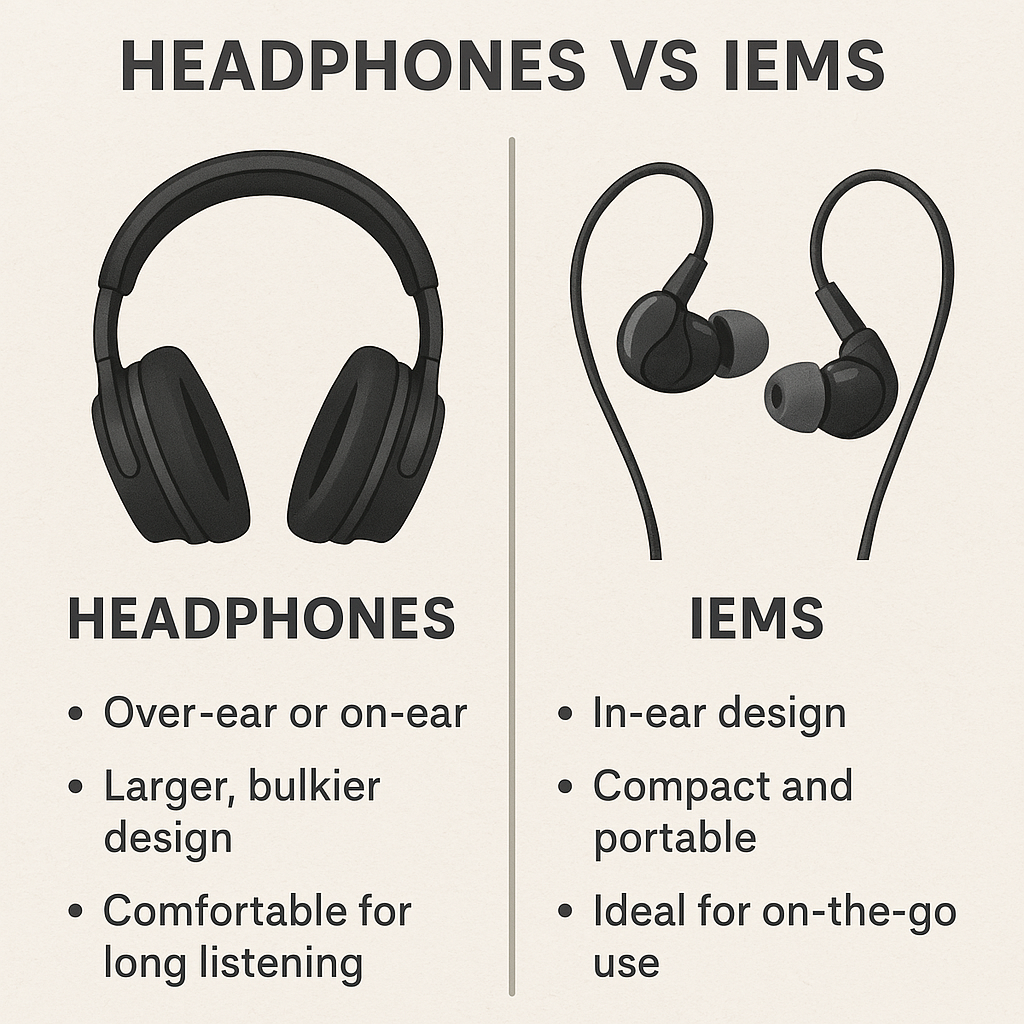Beginning
For both audiophiles and casual listeners, sound quality is top priority among audio equipment. Among the main elements affecting audio experience are headphone imaging and in-ear monitors (IEMs). Each offering distinct experiences suited to various listening tastes, these two kinds of audio devices have attracted significant notice in the audio community. But what about general performance, imaging, and soundstage?

This post will look at the distinctions between headphone imaging and IEMs, the technologies supporting both, and which choice could be appropriate for your listening style.
Imaging in Headphones
Imaging is the degree to which a set of headphones can reproduce the location of sounds inside a three-dimensional soundstage. The imagery lets you see where every instrument or sound is originating from when you listen to music using headphones. Under perfect conditions, excellent imaging lets you separate sounds emanating from the left, right, or even the center, hence enhancing the realistic listening experience.
By their design, headphones have the benefit of full-size speakers that let for a more wide soundscape. Placed close to your ears, stereo drivers produce a broad image that can mimic how sounds or instruments are positioned in space. Especially open-back types, high-end headphones are praised for their remarkable imaging qualities.
What Are IEMs?
Designed to fit inside your ears, In-Ear Monitors (IEMs) are tiny, portable audio devices. IEMs’ small size and capacity to provide great sound isolation have made them increasingly popular. Usually, those who want crisp, high-quality sound without the weight of bigger headphones are artists and audiophiles.
IEMs usually provide a balanced sound profile by using several drivers inside one earpiece. Especially in high-end versions meant for critical listening, these drivers can cooperate to offer a precise and thorough audio experience.
Although IEMs are praised for portability and simplicity, the soundstage and imaging they create may differ from those of headphones. But premium IEMs have come quite close to mimicking the broad imagery seen in full-sized headphones as technology develops.
Headphones Imaging vs IEMs: Main Differences
Soundstage and Imaging Depth
The size of the soundstage is one of the key distinctions between headphone imaging and IEMs. Larger drivers and the capacity for sound to travel freely around your ears cause headphones, particularly open-back types, to produce a more immersive and broader soundscape. Usually, the music is perceived as emanating from a bigger area with depth and breadth that simulates the sensation of being in a concert hall.
IEMs, on the other hand, usually produce a more intimate soundstage because to their small design. Although many high-end IEMs can provide remarkable imaging, they usually lack the breadth or depth of headsets. They shine in detail, though, and their exact instrument location inside the soundstage enables great imaging, particularly in the midrange and treble frequencies.
Sound Isolation and Audio Transparency
Compared to headphones, IEMs provide a better degree of sound isolation. When listening in loud settings or on-the-go, this isolation helps you to concentrate more on the music. The trade-off, though, is that the isolation could occasionally reduce the felt “space” around the music since you are practically blocking out all outside noises.
By letting exterior noises flow through, headphones—especially open-back ones—allow for a more clear sound experience. This openness helps to create a more natural feeling of space and may improve your auditory scene awareness.
Portability and Comfort
IEMs usually outperform headphones in terms of comfort and portability. Lightweight and portable, IEMs are ideal for those who require a small solution for travel or regular commuting. Different ear tips let IEMs fit customised, hence guaranteeing comfort for extended listening sessions.
Conversely, headphones can be larger and less suitable for people who require portability. Although they offer great comfort for long use, they might not be as useful as IEMs regarding mobility.
Which is Better for Imaging: IEMs or Headphones?
When it comes to sound quality, headphone imaging and IEMs have no obvious victor. Your particular requirements and tastes will determine the choice.
Especially in open-back designs, headphones can provide higher imaging depth and a more immersive, broader soundstage.
IEMs shine in detail and accuracy, offering great imaging inside a more constrained soundstage. They are also perfect for people who require mobility without sacrificing audio quality.
Headphones can be your best choice if you are an audiophile wanting a complete, immersive listening experience and don’t mind the size. IEMs can be the perfect option if you desire correct imaging yet require mobility and sound isolation.
Things to Think About While Deciding Between IEMs and Headphones
Sound Quality
Although both IEMs and headphones provide excellent sound, the model and pricing range determine the whole audio experience. While full-sized headphones usually provide a more broad sound that can better mimic the acoustics of a real-world environment, premium IEMs can match or even beat lower-end headphones in terms of clarity and detail.
When compared to headphones in the same pricing range, IEMs can sometimes offer superior value for money. Many IEMs provide great sound for a fairly low price with several driver configurations. Conversely, particularly open-back models of high-quality headphones could be more pricey.
Application
Headphones could be the solution if you mostly listen at home and want comfort and quality above portability. On the other hand, IEMs would be a sensible choice if you need portability and are often on the go as they don’t compromise sound quality.
READ ABOUT:A Comprehensive Artist’s Guide to Mastering Headphone Drawing
FAQs Regarding Headphones Imaging vs IEMs
- For imaging, what distinguishes headphones from IEMs?
While IEMs emphasize exact imaging in a more constrained soundstage, giving superb detail but less depth, headphones give a more immersive experience and a larger soundstage. - Do IEMs outperform headphones for bass?
While headphones, particularly closed-back types, may give more powerful bass because of their bigger drivers and superior air movement, high-quality IEMs can deliver deep and precise bass. - Do IEMs provide a comparable imaging experience as headphones?
Although IEMs usually lack the broad soundstage of headphones, premium IEMs can nonetheless provide remarkable imaging accuracy, especially in the mid and high frequencies. - Do closed-back headphones outperform open-back ones for imaging?
Open-back headphones usually offer a more realistic, broad soundstage with improved imaging since their design lets sound travel freely. - Which is more comfortable: IEMs or headphones?
This is based on the user’s choice. While IEMs are more comfortable for those who want portability and a lighter fit, headphones offer more comfort for long listening sessions.
Final Thoughts
When it comes to sound quality and listening pleasure, both headphone imaging and IEMs have unique benefits in the field of audio equipment. For home use and audiophiles wanting rich, broad sound, headphones usually offer a more immersive and larger soundstage. Conversely, for people on the go or those who want a more intimate listening experience, IEMs provide great portability, sound isolation, and precise imaging.

